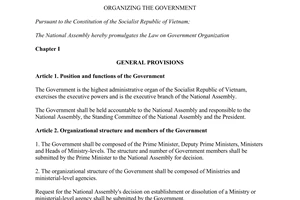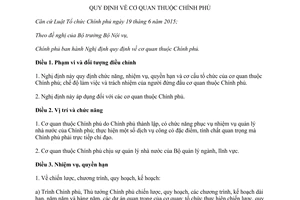Nội dung toàn văn Decree 10/2016/ND-CP government attached agencies
|
THE
GOVERNMENT |
THE SOCIALIST REPUBLIC OF VIETNAM |
|
No. 10/2016/ND-CP |
Hanoi, February 1, 2016 |
DECREE
ON GOVERNMENT-ATTACHED AGENCIES
Pursuant to the June 19, 2015 Law on Organization of the Government;
At the proposal of the Minister of Home Affairs,
The Government promulgates the Decree on government-attached agencies.
Article 1. Scope and subjects of regulation
1. This Decree prescribes the functions, duties, powers and organizational structures of government-attached agencies; and working regimes and responsibilities of heads of government- attached agencies.
2. This Decree applies to government-attached agencies.
Article 2. Positions and functions
1. Government-attached agencies shall be established by the Government, to serve state management tasks of the Government; and shall deliver a number of public services with important characteristics and natures requiring the Government’s direction.
2. Government-attached agencies are subject to the state management by line ministries.
Article 3. Duties and powers
1. For strategies, programs, masterplans and plans:
a/ To submit to the Government and the Prime Minister strategies and master plans and long-term, five-year and annual programs and plans and important projects of agencies; to organize the implementation of approved strategies, master plans, programs and plans;
b/ To participate in the appraisal of important plans and projects within their professional operations at the request of the Government and the Prime Minister;
c/ To decide on investment projects within their competence in accordance with law.
2. For delivery of public services assigned by the Government:
a/ To formulate and submit to competent authorities for promulgation national standards; to promulgate the criteria, and mechanisms for supervision, assessment and appraisal, of the quality of public services assigned by the Government in accordance with law;
b/ To announce basic standards; to promulgate the professional process and economic- technical norms for delivery of public services assigned by the Government;
c/ To organize the delivery of public services assigned by the Government in accordance with law;
d/ To examine and supervise the organization of delivery of public services of attached agencies, organizations and units in accordance with law.
3. For international cooperation:
a/ To propose the conclusion, amendment, supplementation, extension and termination of effect of treaties, and suspension of the implementation of treaties in accordance with law;
b/ To organize the implementation of treaties as assigned by the Prime Minister;
c/ To conclude, amend, supplement and extend international agreements, and terminate effect or suspend the implementation of international agreements in the name of government- attached agencies in accordance with law;
d/ To organize and examine the implementation of foreign sponsored programs and projects in accordance with law;
dd/ To participate in international cooperation conferences, workshops, programs and plans in accordance with law.
4. To decide on and direct the implementation of the administrative reform program in conformity with the objectives and contents of the state administrative reform program approved by the Prime Minister.
5. For information and reporting regimes:
a/ To organize information on and dissemination of political tasks, policies, regimes and laws of the State in assigned sectors or fields;
b/ To report to the Prime Minister or ministers in accordance with law.
6. For organizational apparatus, payrolls of civil servants, number of employees and working positions, and structure of civil servants and public employees based on ranks and professional titles:
a/ To submit to the Prime Minister for decision the establishment, reorganization and dissolution of organizations and units under their organizational structure;
b/ To define the functions, tasks, powers, organizational structure and work relations of attached organizations and units;
c/ To propose the Prime Minister to appoint, relieve from duty or dismiss deputy heads of government-attached agencies;
d/ To appoint, relieve from duty or discipline heads and deputy heads of attached organizations and units in accordance with law; to define the competence and responsibilities of heads of attached organizations and units;
dd/ To make the List of working positions and professional title-based structure of civil servants and public employees to determine the annual number of public employees working in their public non-business units for submission to the Ministry of Home Affairs in accordance with law;
e/ To manage working positions and the number of civil servants and public employees of their public non-business units in accordance with law;
g/ To decide on and organize the implementation of specific measures to enhance the observance of administrative disciplines and rules of cadres, civil servants, public employees and employees under their competence; to combat corruption, waste, bureaucracy, imperiousness and authoritarianism in activities of agencies;
h/ To organize the training, retraining, recruitment, employment, transfer, rotation, retirement, commendation and disciplining of, and implementation of other regimes for, civil servants, public employees and employees under their management in accordance with law;
i/ To examine the observance of policies and laws and assigned tasks by civil servants, public employees and employees under their management; to settle complaints and denunciations related to civil servants under their competence in accordance with law.
7. For financial and asset management:
a / To make their annual budget estimates and three-year finance-state budget plans for submission to competent state agencies in accordance with law;
b/ To coordinate with related ministries and sectors in formulating financial mechanisms and regimes, standards and norms for budget expenditures of agencies in the assigned fields;
c/ To perform finance and accounting management in accordance with law;
d/ To manage and effectively use assigned state assets.
8. To implement a number of state management tasks in assigned sectors and fields in accordance with law.
9. To implement other tasks and powers assigned by the Government and the Prime Minister and in accordance with law.
Article 4. Organizational structure
1. The organizational structure comprises:
a/ Departments;
b/ The office;
c/ Other attached non-business organizations (if any).
2. Organizations mentioned at Point a, Clause 1 of this Article shall operate under the regime of head ship, shall not have their own seals, may have their attached sections and shall be detailed in the Government’s Decrees defining the functions, duties, powers and organizational structure of each government-attached agency.
3. The office mentioned at Point b, Clause 1 of this Article may have its own seal; and shall sections or teams.
4. The number of deputy heads of organizations prescribed in Clause 1 of this Article must not exceed 3.
5. In special cases where an attached agency bears another name, the Government shall review and decide in conformity with the functions and duties of each government-attached agency.
Article 5. Heads and deputy heads of government-attached agencies
1. Heads of government-attached agencies shall be appointed or relieved from duty by the Prime Minister; and shall be held responsible for all activities of government-attached agencies before the Government, the Prime Minister and law.
2. Deputy heads shall be appointed or relieved from duty by the Prime Minister at the proposal of their heads; and shall assist their heads in directing and settling a number of fields of work and be held responsible before the heads and law for their assigned tasks. The duties of deputy heads shall be assigned by their heads.
3. The number of deputy heads of government-attached agencies must not exceed 4.
In case of merger of government-attached agencies or due to transfer and rotation requirements of competent agencies, there may be more deputy heads but the number of whom must not exceed 5 and shall be reviewed and decided by the Prime Minister.
4. Heads of government-attached agencies may not promulgate legal documents.
Article 6. Responsibilities of heads of government-attached agencies
1. Heads of government-attached agencies shall take responsibility before the Government, the Prime Minister and law for the performance of functions, duties and powers of their agencies; and shall be held responsible for management shortcomings or occurrence of corruption and bureaucracy, causing damage in organizations and units under their management.
2. Heads of government-attached agencies shall report to the Government and the Prime Minister on the organization and activities of their agencies and the performance of assigned tasks; ask for opinions of the Prime Minister on issues beyond their competences; attend the Government’s meetings upon request of the Prime Minister; coordinate with ministers, heads of ministerial-level agencies and heads of other government-attached agencies, central agencies and socio-political organizations in settling issues related to their functions, duties and powers; and settle proposals and petitions of provincial-level People’s Committees in conformity with their assigned functions, duties and powers.
Article 7. Working regimes of government-attached agencies
1. Government-attached agencies shall operate under the regime of headship.
2. Heads of government-attached agencies shall promulgate the working regulations and information and reporting regimes-of their agencies, and direct and examine the implementation of such regulations.
Article 8. Effect
This Decree takes effect on March 20, 2016.
Article 9. Implementation responsibilities
Ministers, heads of ministerial-level agencies, heads of government-attached agencies and chairpersons of provincial-level People’s Committees shall implement this Decree.-
|
|
ON BEHALF OF THE GOVERNMENT |

